Pad kee mao ผัดขี้เมา or drunken noodles is stir fried rice noodles with holy basil and lots of chilies. It's a cult-favourite Thai street food. The combination of chewy fresh rice noodles, the epic savoury sauce, and the fragrance of holy basil ... there is nothing quite like it and it never gets old.
In this recipe I share 7 secrets to making the perfect, authentic pad kee mao, guaranteed to make this better than take out; and once the prep is done it takes literally 3 minutes to make each portion. You can see the video in the recipe card where I show the cooking in real time!

Want to save this recipe?
Ingredients and Notes
Here are all the ingredients for drunken noodles and important notes about them. Ingredient amounts will be in the recipe card below. You can change up the vegetables and I love using carrot and Chinese broccoli, though traditionally baby corn, long beans, and straw mushrooms are often added.
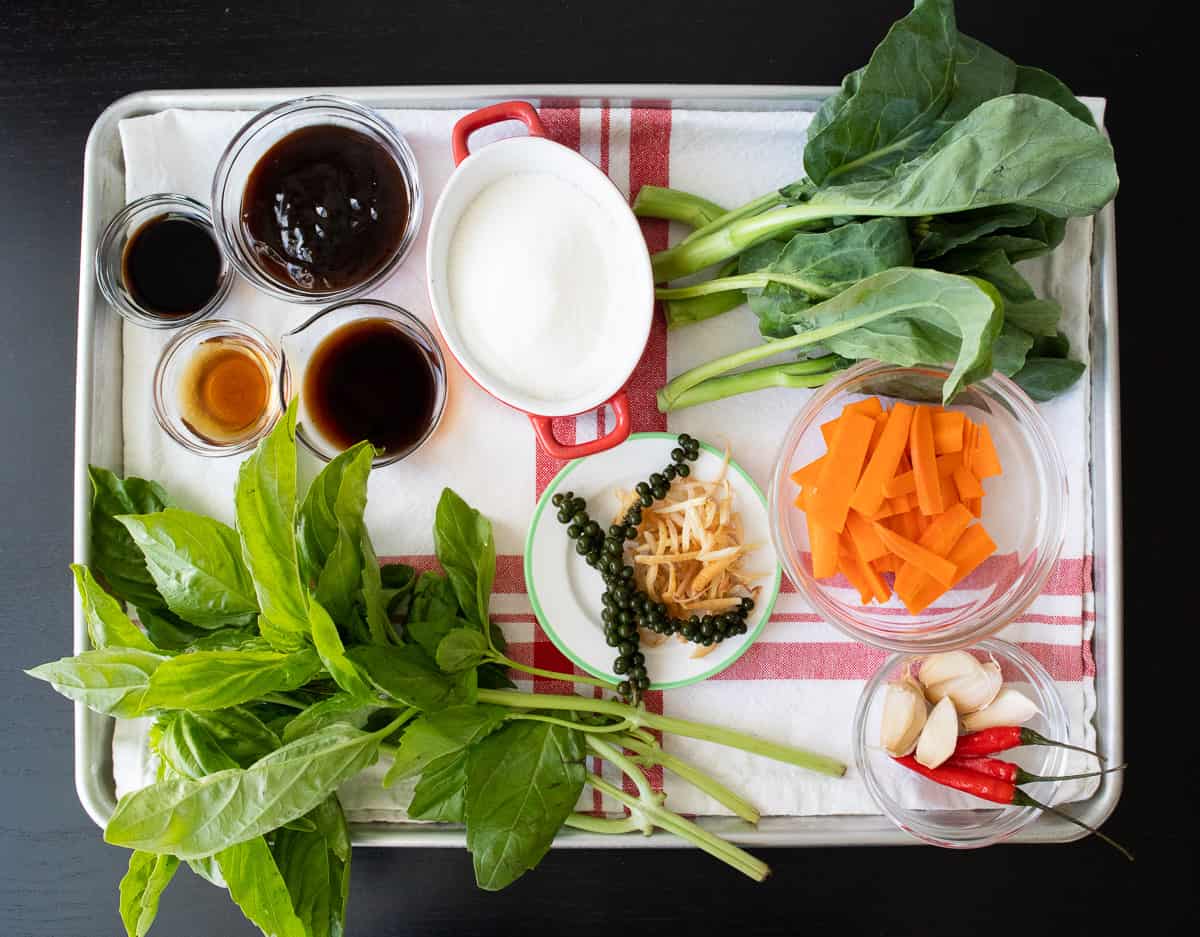
- Soy sauce. I use Healthy Boy Brand soy sauce which is a classic Thai brand, but any other kind of regular or light soy sauce can be used.
- Golden Mountain Sauce. This is another kind of soy sauce with a slightly more intense flavour, you can substitute Maggi Seasoning which is very similar, or use more soy sauce.
- Oyster sauce. See this post for how to choose good oyster sauce.
- Fish sauce. See this post for how to choose good fish sauce.
- Sugar
- Chinese broccoli, also known as gai lan. Choose young, small stems if you can as they are less bitter.
- Carrot
- Young peppercorns. These are totally optional. They can be found fresh or brined in glass jars at some Southeast Asian stores. They are added whole and still on the stems, and when eating you can pick out the peppers and eat them for extra heat.
- Fingerroot (grachai). Also optional but they do add a lovely herbaceous aroma. They can be found fresh or brined in a glass jar at Southeast Asian stores.
- Holy basil. Holy basil can be hard to find, you can sub regular Italian basil or Thai basil instead, but I do find Italian basil to have a flavour more similar to holy basil.
- Garlic
- Thai chilies. Add as many as you want depending on your spice tolerance. If your tolerance isn't high, add just one to start.
- Large, mild red chilies such as spur chilies (pic below), anaheim peppers or red bell pepper.
- Protein of your choice, I'm using shrimp. If using chicken, pork, or beef, a quick and simple marinade will be helpful. Instructions in the recipe card below.
- Fresh rice noodles also known as ho fun noodles. If you buy them from the store they may be cold and stuck together in a block. You'll need to reheat them before separating, following instructions in the recipe card. It is possible to use dried large rice noodles instead but it is not as good, and you will need to cook them first before using.

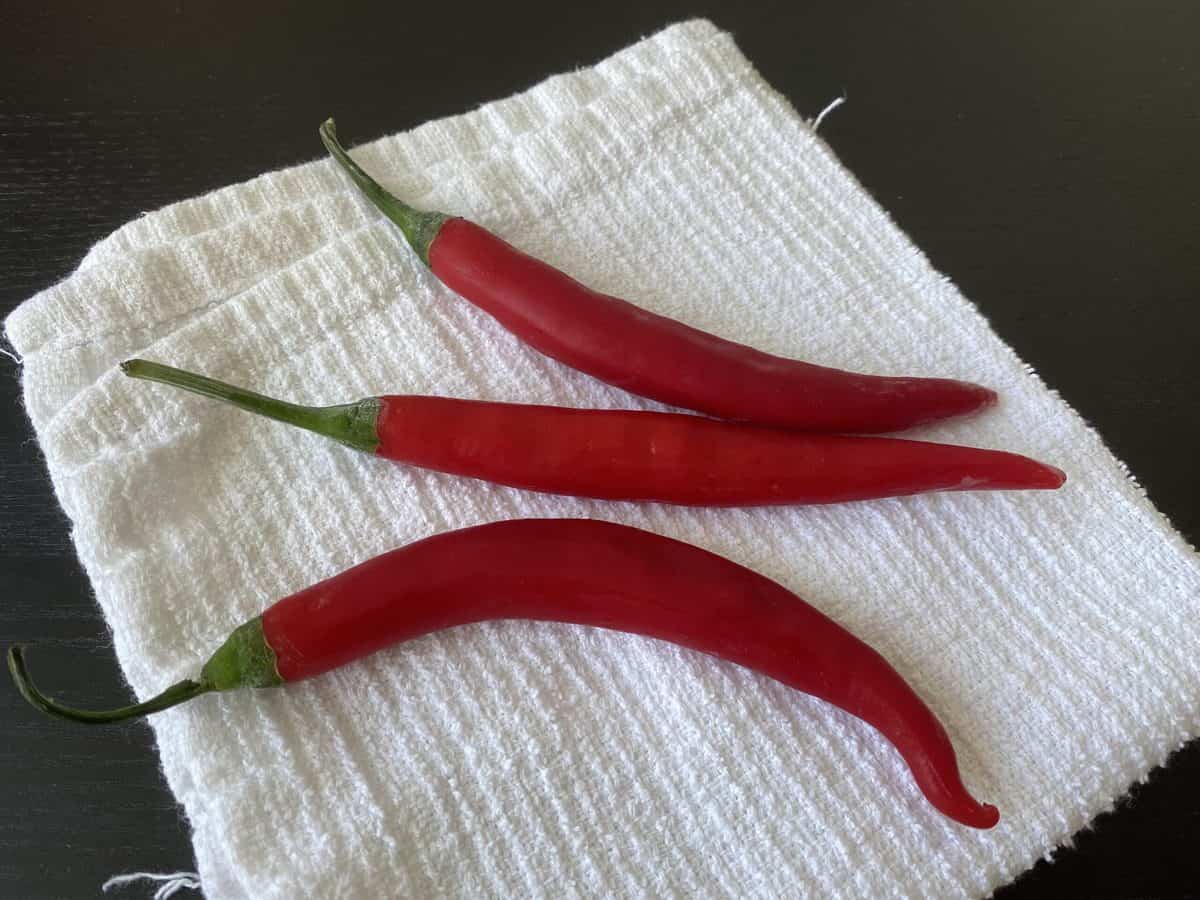
Why I use 2 types of chilies in this recipe
Pad kee mao uses a lot of chilies, so the chili flavour, not just the heat, is part of the flavour profile. If we only used the fiery Thai chilies, we can only add a few before it becomes too spicy, and not enough chili flavour would come through. So we also use the milder chilies to add more chili flavour without the heat.
In Thailand, prik chee fa, or spur chilies are used, but any mild red pepper such as anaheim peppers or even red bell pepper would work in a pinch.
How to Make Authentic Drunken Noodles
Be sure to check out the detailed recipe and full video tutorial in the recipe card below to ensure success - but here's a bird's eye view of what you'll need to do.

- Make a rough paste with chilies and garlic.
- Cook off the protein and remove from the pan.
- Sauté the chili garlic paste.
- Add gai lan stems, carrots, grachai and young peppercorns.

- Add the noodles, the sauce, and sugar and toss until the sauce has been absorbed.
- Let noodles sit and char slightly before tossing. Then repeat the charring a few times.
- Add gai lan leaves and holy basil.
- All done!
7 Secrets to Epic Pad Kee Mao
It is not hard to make a decent plate of drunken noodles, but an epic one? Not so simple. There are a few things you need to know:
- Do not eyeball the ingredients. Weigh the noodles, and measure all sauce ingredients. There are times when winging it is okay, and using your cook's intuition is romantic. But this is not one of those times. The noodle-to-sauce ratio is extremely important, and there's nothing more disappointing than pad kee mao that's bland, or worse, too salty (which cannot be fixed afterward).
- Make a chili and garlic paste. One of the great flavours of drunken noodles come from the garlic and chilies. Adding chopped garlic and chilies can only get you so far, but pounding them into a paste in a mortar allows for more flavour to come out and infuse into the whole dish. Also, adding extra peppers that are not spicy gives more chili flavour without it becoming too spicy.
- Cook 1 portion at a time. This is the secret to well-charred noodles that are not broken or soggy. Crowding the pan traps too much moisture and causes you to stir more which breaks the noodles. If you have a large wok and a high BTU burner, you can probably get away with 2 portions at a time. It seems tedious but watch the video below and you will see that once the prep is done, each batch literally takes 3 minutes to cook!
- Cook the protein separately, and do a "mini brine". By cooking off the protein first and adding it back in at the end you can control exactly how long it cooks, ensuring perfectly cooked protein every time. Good news is you do not have to cook the protein 1 portion at a time, just cook it all off together in the beginning. Also, if using chicken, pork, or beef, marinate it with seasoning plus a little extra water, like a mini brine, to get extra juicy meat.
- Allow noodles to char. Once noodles are mixed with the sauce, allow them to sit and "grill" a bit on the hot pan. This creates a little browning, a little smokiness, and a little extra flavour that makes all the difference.
- Use fresh noodles. Yes, dry rice noodles exist; and they will work, but it is not the same and not nearly as good as fresh. Cooked previously-dried rice noodles do not yield the same soft and springy texture of fresh noodles, in the same way that cooked dried pasta is not the same as fresh pasta. I understand you gotta use what you have, but if you can, it's worth either looking around for them or making them yourself.
- Use a stick-resistant pan. These fresh rice noodles are notoriously sticky. So it's important you use either a well-seasoned carbon steel wok, a well-seasoned cast iron skillet, or a nonstick wok. BUT if using a nonstick material that cannot be used with high heat, you will have to give up some noodle charring.
*If you only have a stainless steel pan, you can try this: Heat the pan until very hot - until water sprinkled onto the pan beads up into little balls and glides around - then add the oil and begin cooking. This is a trick that turns stainless steel pan nonstick which I've tried with eggs with success, but have not tried with fresh rice noodles.
ALSO IMPORTANT: Make sure you watch the video in the recipe card below! You'll see me cooking pad kee mao in REAL TIME with no cuts. It'll show you how it's done in only 3 minutes, give you an idea of how the process goes and how to organize your prep, and I promise it'll be so helpful for when you cook!
Frequently Asked Questions
You can make them using my recipe here! You can also use dried wide rice noodles, but the results are not nearly as good and you will need to fully cook them before adding to the pan. You can read my post here all about mastering rice noodles to learn more about different types of noodles and how to cook them properly.
Yes! Anything works, or even omit the protein altogether. If using chicken, pork, or beef though, I would marinate them following the instructions in the recipe card. That simple marinade yields wonderfully tender meat with the extra bit of water that gets absorbed into the meat.
You can use vegetarian stir-fry sauce instead of oyster sauce, and use soy sauce instead of fish sauce. You can also do a simplified version and use 2 parts soy sauce to 1 part Golden Mountain Seasoning Sauce.
These noodles do not keep well, so if at all possible, cook only as much as you can eat. Once refrigerated and reheated, the noodles will not have as good of a texture and can be a bit mushy. Having said that, if you do end up with leftovers, do not keep it for any longer than 1 day. The next day, reheated pad kee mao is still edible, but after a couple of days...I wouldn't eat it.
To reheat, you can microwave it, but stir it halfway through and make sure the noodles are thoroughly heated through or they will not be soft, which is really awful. You can also re-fry it quickly in a nonstick pan, again, making sure the noodles are steaming hot.
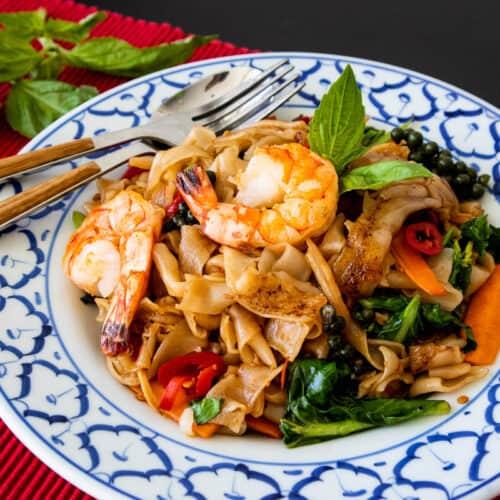
Pad Kee Mao - Drunken Noodles
Ingredients
- 1 lb fresh wide rice noodles, (see note 1)
- 4-5 cloves garlic
- 1-3 Thai chilies, or to taste
- 1 spur chili, or ⅛ red bell pepper, chopped
- 8 oz protein of your choice, (see note 2)
- 2 oz carrots , cut in thin sticks
- 2.8 oz Chinese broccoli, (see note 3)
- 2 tablespoon julienned grachai , (optional)
- 2 stems young peppercorns, cut in small chunks (optional)
- 2 ½ teaspoon sugar
- A dash black or dark soy sauce, (optional, see note 4)
- 2 cups holy basil leaves , (see note 5)
Pad Kee Mao Sauce - For 2 Servings (see note 6)
- 2 tablespoon oyster sauce
- 1 tablespoon soy sauce
- ½ tablespoon Golden Mountain Sauce, or substitute more soy sauce
- ½ tablespoon fish sauce
Want to save this recipe?
Notes
FULL VIDEO TUTORIAL
All my recipes come with step-by-step video tutorials with extra tips not mentioned in the blog post, so make sure you watch the video to ensure success. If you enjoy them, consider subscribing to the YouTube Channel to not miss an episode. Thank you!
Subscribe to my YouTube ChannelInstructions
- *I highly recommend cooking 1 portion at a time for best results, so divide up your prep before you start cooking.
- Mix the sauce ingredients together in a small bowl and stir to combine.
- Separate the rice noodles from each other (see video for technique). If they are cold, hard and stuck together, you need to heat them up until soft or they will break when you try to separate them. Carefully divide the noodles into 3-4 smaller bundles and spread them out onto a large plate. Microwave at 70% power, stopping every minute to move the noodles around for more even heating. Once they are soft, pull the noodles apart and divide them into portions.
- Add Thai chilies into a mortar and pestle and pound until fine. Add garlic and spur chilies and pound into a rough paste.
- Before you cook, organize your prep: 1) separate the ingredients into batches; 2) combine all non-leafy vegetables, grachai and young peppercorns together; 3) put the basil and leafy greens together; 4) put a tablespoon measure into the sauce and a teaspoon into your sugar crock.; 5) have a bowl ready to put your cooked protein into.
- In a well-seasoned or non-stick wok, heat about 2 tablespoon of vegetable oil over high heat. Once very hot, add your protein to the pan and spread it out into a single layer. Sear on one side until browned or halfway cooked, then flip or toss and cook the other side until done. Remove from the pan and set aside.
- Put the pan back on the stove with the heat still off, add the chili/garlic paste and a little more oil if needed. Turn heat on to medium and stir just until the small pieces of garlic start to turn golden brown.
- Add your bowl of non-leafy vegetables, turn the heat on high and stir for about 30 seconds.
- Add the noodles, drizzle the sauce (2 tablespoon per serving) and sprinkle the sugar (1¼ teaspoon per portion; you can eyeball the ¼ tsp) and toss until all the noodles are evenly coated and the sauce has been absorbed. If you want a darker colour, you can add a dash of black or dark soy sauce at this time, a little at a time.
- Once the noodles are well coated, add the protein back in and toss to mix. Then let the noodles sit in the pan without stirring for 15-20 seconds or until the noodles are charred in some spots. Flip the noodles and repeat 1-2 more times.
- Add the basil and any leafy greens and turn off the heat. Toss for just a few seconds until they wilt. Plate and repeat with your other batches. Enjoy!

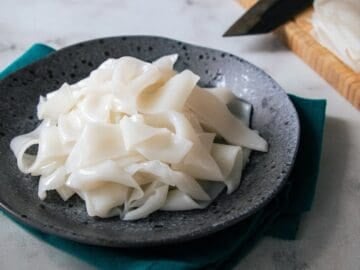
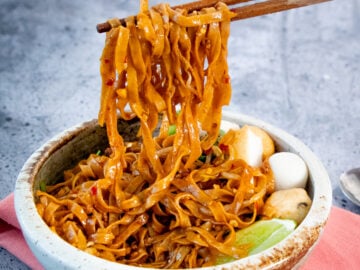
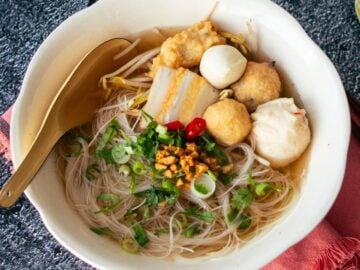
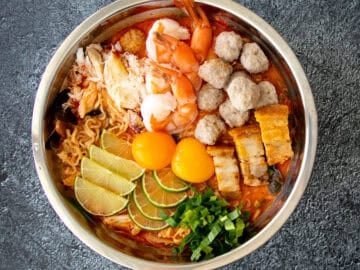
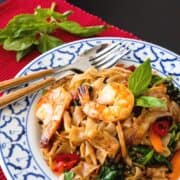
louella says
Even on my first try, with plenty of substitutions, this is better pad kee mao than I've had in the state of Michigan. Thank you, a million times thank you.
Forest says
Where does the sweetness come from in this recipe? I notice many others have palm sugar or sweet soy but you recipe does not. Could you comment on this? Thanks so much!
Christopher Maurer says
I like this recipe but the sauce needed more salt/fish sauce and more sugar even though I used sweetened soy sauce. Mixing a little sweet chili sauce into the cooked result helped a lot.
M says
How many (what is the weight of the) noodles do I use per portion?
Pailin Chongchitnant says
Ingredient amounts are in the recipe card in the bottom of the post!
Jennifer says
Pad Kee Mao is one of my favorite dishes and thanks to you, I'm really good at making it at home now! I appreciate all your info on ingredients and your videos. I'm lucky enough to have access to authentic ingredients and I think it makes a huge difference, but I wouldn't know what I was doing without all of the information you provided and your recipes.
Suresh Sampath says
This recipe was absolutely spot on. I made it exactly the way you had shown except for using Thai basil inatead of the hard to find holy basil and it was outstanding. I felt it was better than all of the Thai restaurant pad kee mao’s I’ve had in the USA.
Don Carr says
I made this last week and it was great. Next time I will use glass noodles (Woon Sen)
Suzanne Martin says
This was totally delicious! Next time I will cook the noodles a bit longer. They tasted great anyway because of frying them a little. Thanks for that advice. Chinese broccoli is so good! I lost my thai chili's enroute from the store so I used Sriracha instead. I will definitely be repeating this one! Thai food is a gift from heaven!
Suzanne says
I sent my husband to the Asian grocery store for one pack of thai basil for pho and he came back with 6 packs! This will be a perfect recipe to use my basil up. Thanks!
Chris says
Hi Pailin,
I made this tonight, and really enjoyed it - similar enough to the Pad See Ew that I've gotten used to, but with that nice bit of chili heat. The issue I had tonight was my basil - I found Thai Holy Basil at a Chinese grocery up in Massachusetts last month, and I froze what I didn't use. I threw it in late with my gai lan leaves, but it came out very tough and waxy. Many leaves were too chewy to be enjoyable. The flavor was good on the thinner ones, and everything else was great. Do you think this was maybe related to my freezing it? Or did I simply get some poorly grown Holy basil? It looked right, but the leaves were fairly thick and glossy looking. Or, should I have cooked the Thai basil longer than I would have with typical sweet basil? Thanks for any ideas you might have! Looking forward to trying this one again!
Andrew Eames says
Very enjoyable recipe, though I am willing to admit that next time I will probably halve the grachai or leave it out entirely. It's an interesting flavor and makes for a very herby dish (especially combined with the basil and peppercorns), but for me it takes away a little of the "comfort" aspect that I enjoy with drunken noodles. Five stars for your overall body of content, though - always extremely helpful!
Mohini says
These drunken noodles are fantastic. My all time favorite dish, I have been trying to make these at home for YEARS! Have tried at least 5 different recipes, most that I have had to convince myself to actually eat because they were so meh. These taste like restaurant style drunken noodles. SO GOOD. Your video is extremely helpful to learn how to actually cook each ingredient - with limited ingredients, the order of food is so important. And the tips you provide have really allowed for a flawless dish to come together. I did add a little more sauce and sugar to each batch for personal preference but would not change a thing! The universal sauce is GOLD! Cannot thank you enough for this beautiful and delicious recipe, Pailin!
Karri Hicks says
Just made it for tonights dinner. Delish! Will definitely be making it again!
Jaymie says
I want to make this for a pool party! But do you think this will last outside in the shade or will it go back quickly if it’s too hot?
Pailin Chongchitnant says
This is something that I think should be served relatively quickly after it's made, as cold rice noodles don't taste good. So it won't go "bad" but the texture won't be as good.
Kashfia Rahman Angel says
Wow! Certain ingredients I couldn’t find, certain ingredients it took me a long time to find. Holy basil has such a different taste than Italian basil that I personally wouldn’t add Italian basil if I couldn’t find holy basil. Make the effort to find Thai soy sauce. It makes all the difference. Also the fresh rice noodles, if I couldn’t find fresh rice noodles I wouldn’t bother with dry. Fresh is unreal!
Sydney Lou says
I've tried a few recipes for drunken noodles and yours is the best by far. The tip on separating the rice noodles is a game changer. Thank you!
T says
Absolutely perfect. I have a new staple dish!
Brittini says
Tasted just like Thai takeout! I added a tomato which I got at the Asian Market and then made AS IS using holy basil. Sooooo good! Thanks for sharing! I immediately bought the cookbook.
Elena says
Is there any easy-to-find substitute for grachai and peppercorns? Internet suggests ginger or galangal for grachai but it doesn't sound right...
Pailin Chongchitnant says
You are right to not believe the internet! There's no good substitute for grachai, unfortunately. There's just nothing that tastes like it and I would just leave it out, cuz anything else you add will just introduce the "Wrong" flavour. Many people don't add grachai to their pad kee mao, so it's not really required anyway. For the peppercorns you can add some fresh ground white pepper.
Nora says
What a gold mine of information you are! Your in-depth and thoughtful discussion on South-Asian ingredients is super helpful. It is like a user guide to my local Asian market. Thank you!
My Drunken Noodles were delicious. I had a few challenges (mostly having to do with the proper prep of my noodles) but once I got that down everything went swimmingly. Making the second batch tonight 🙂
Daniella says
I have a question. I don’t have a microwave to warm the noodles. Could I just use warm water to warm through? Or would that mess up the noodle?
Pailin Chongchitnant says
Definitely do not put them in water! Cover them with a towel and steam them 🙂
Laura says
Hi Pailin!
First of all let me tell you how much I love your blog and YouTube channel! My husband and I followed your instructions for making homemade rice noodles before we took a Skype cooking class with a woman in Chiang Mai!
Anyhow, I hit up my Asian market today and secured some grachai and peppercorns in brine. Do you rinse both before adding?
Thanks!
Laura
Sejal says
Followed the recipe precisely and weighed all the ingredients - it turned out amazing! We will definitely repeat this recipe.
AK says
Hi,
In version 1 of the recipe the fish sauce called for 2 tsp, but version 2 calls for 1 tbsp.. it causes the dish to be a bit salty if making a protein-less dish as I found out yesterday.
Pailin Chongchitnant says
Hi, this version actually calls for half a tablespoon, so that would be why it was too salty.
AK says
Hi Palin,
Actually to have a fair comparison we need to see 2x ingredients in version 2 versus the ingredients in version 1. That way you'll see it is 1 Tbsp fish sauce in V2 versus 2 tsp in V1.
It'd be nice if you could update if you agree, I have been following V1 successfully. 🙂
Jessica says
Hello. I plan on making this recipe as it is difficult to find Asian food restaurants that meet my needs as I have celiac disease. In your video you mention to weigh the noodles but I can seem to find/ hear the amount that it should weigh. Can you tell me the weight of the oration of noodles I should be using, please?
Thank you
Adam from HTK says
Hi Jessica! Adam here - and the weight is in the Ingredients section with additional notes. Can you see it there? Cheers!
Alison says
I love Pailin! Her sunny energy and knowledge make her a great video teacher. However, I had the same question as Jessica. In the notes it says I will need 6 oz. Total? So, for 2 servings, I will use 3 oz per serving? Just explain in the recipe to measure out 3 oz (if I’m correct in my assumptions/calculations); otherwise, we have to be detectives.
PS so lucky I can find fresh wide rice noodles in Los Angeles which California has allowed to be left out of the refrigerator at the store for one day, (keeping the integrity of the noodle).
Alison says
I am updating my comment. I realized that the 6 oz noodle notation was for dry noodles. I ended up eye-balling the amount from the video. I finally saw that it’s written that a pound of fresh noodles (to which I have access) or half a package is needed. So, 8 oz of fresh noodles per serving or 3 oz dry.
Although I couldn’t find find the grachi (at the time) nor young peppercorns, this recipe was a hit. I appreciate all the advice given.
Thank you for your wonderful recipes and instructions!
Pailin Chongchitnant says
Hi Alison, glad you figured out the noodles! So glad it turned out well!!
Margaret says
I love drunken noodles & tried multiple recipes. This one has best result & delicious. My husband loves it too. BTW l enjoy your YouTube too.
Thanks
Jeremy says
Great Recipe! I think there is some confusion because of serving sizes compared to past recipes. I think it should be 2 tbsp of TOTAL sauce mix PER SERVING. I almost made the same mistake others did and did double that by accident. Glad I double checked. I think grachai (fingerroot) and baby corn + carrot are essential. So good!!! I freeze my grachai in ice cube trays so that I never run out! And I like to use Mama noodles (instant ramen noodles) as well. 🙂 Thanks for this super recipe
Adam The HTK Minion says
Hi Angela! Did you put all the sauce in all at once? The recipe is for 2 servings. Cheers!
Cherry says
Wonderful recipe! Thank you! I've made it 3 times now and each time it comes out super delicious! I was also able to use the krachai and the peppercorns! Nice touch of flavor. Not too salty at all! Perfect balance!
Adam The HTK Minion says
Hi Cindy! Are you by any chance are you adding all the sauce to one serving? This recipe is for 2 servings, so you have to add half the sauce to each.
Otherwise I had it myself and it was fine.
Cheers! Adam
Hendrik says
I just made the old version two days ago. Interesting to see krachai added. The garlic seems rather hefty even by Thai standards.
For holy basil I use African blue basil - look in Wikipedia for the pic - it is more readily available in Europe as a plant and is easy to grow on the balcony. It is nearer to Genova Basil than Thai Basil, but more savory than the former. I actually looked for recipes to use it in, because it grows so abundantly.
The metric has 12.5 ml (!) for sugar, I s'pose it ought to read gram?
Hendrik says
... oh, and I used 10mm wide dry noodles. I soaked them in hot water for 12', enough to make them pliable but not anywhere near as mushy as they would've been had I cooked them.
Orapin Wade says
Sawadee ka,
Will your home made fresh rice noodle work with this?